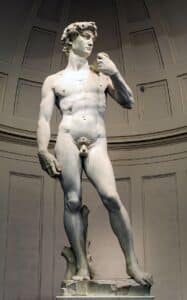The interpretation of art consists of analyzing the elements contained in the work of art. In this way, the viewer will better understand what the artist wanted to convey when he produced the work of art.
By Yolanda Silva, author of the online course Art Analysis
A short reflection about the interpretation of art

The interpretation of art is therefore a complex and not always easy process.
We mustn’t forget that a work of art is an object of aesthetic enjoyment, but it is also a testimony and a historical source regarding the time in which it was produced. It conveys sensations and emotions, but also relevant historical information.
The role of the observer
Nor should we forget that in the interpretation of art, the observer has already internalized a large amount of information.
Relative to the work, the artist, the style or artistic movement. This means that when observers first come into contact with a work of art, their reaction is rarely strictly sensory or emotional.
The viewer’s first reaction to the interpretation of art
Faced with a famous work of art, for example, the viewer will have an emotional reaction but also identify the historical elements present (from the images to the technique and colors). This first reading is “filtered” by the observer’s own experience and internalized information (consciously or not).
what is a work of art
If we want to try to answer the question: what is a work of art, we have to think that it is simultaneously:
- object (a physical object with all the aspects relating to its materiality).
- message (what the author wanted to convey).
- information (what it reveals about the context in which it was produced).
- sensation and emotion (what the viewer feels about the work).
- interpretation (what the viewer “reads” according to their experiences, consciously or not).
Next, Yolanda Silva gives some guidance about the interpretation of art and the general aspects to consider.
About what is art and how this concept is defined. You may be interested in the article "What is art".
interpretation of art
As Heidegger tells us (The Origin of the Work of Art):
“The work publicly makes something else known, reveals something else to us; it is allegory. In the work of art, something else is added to the manufactured thing. (…) The work of art is a symbol.”
Unfolding the artist’s thought by the interpretation of art
In this way, and following Heidegger’s reasoning, it becomes necessary, when the interpretation of art is made, to unfold the artist’s thought at the time of the making of his work.
This reading will remove the character of the “thing” (das Dinghaft, according to Heidegger) and transform it into something more.
The work is wood, stone, canvas, yes; but not only
It has this “thing” element, but it is something more, because there is a meaning intrinsically linked to the “thing”; a meaning that was attributed by the artist himself when he worked the wood, carved the stone or painted the canvas.
Therefore, we must seek out the true essence reigning in its production, analyzing every detail of production carefully, and “ask the work what it is and how it is” (Heidegger).
how to analyze a work of art
So how do you analyze a work of art, whatever its nature or technique?

The analysis can be objective (or visual), describing the elements as they are seen, or subjective (or symbolic), describing our feelings when viewing the work.
We can also analyse a work of art from a formal (or aesthetic) point of view, which looks at the entire visual syntax (composition), with historical context, theme, organization of elements – which involves more extensive research.
reading a work of art
As a reading can be very dependent on the sensations it provokes in each of us, some basic elements for reading a work of art have been established. Thus, these common criteria must be taken into account: period, technique, theme and resources used by the artist.
preliminary research
Therefore, and whenever necessary by resorting to research, before starting the reading itself, we should:
1) Obtain information about the author (such as date of birth and death, social origin, education, other works);
2) Recognize the subject (religious, historical, mythological, allegorical scene, portrait, landscape,…; if it is on display, and when it first appeared in public, etc.);
3) Analyze the subject (i.e.: a description of what is represented, places, framing, characters, actions, etc.).
If necessary, we can also add information about where it is, creating a brief caption: author, title, date of execution, support, dimensions, place of conservation/exhibition.
the importance of registration in the interpretation of art
When we describe a work of art, we should start by writing down our first impressions. They can help us at a later stage in the interpretation of art .
However, it should be borne in mind that we should always justify our conclusions so that others can relate to them and thus understand them. We can, for example, make comparisons between works or even between artists and consider alternatives that might have been chosen by the artists or what might have affected their choices in that particular work.
Finally, we should conclude our analysis with a decoding of the meanings (real or symbolic) of the work under analysis.
And remember: in interpretation of art everything that is actually observable in the work is worthy of note and cause for analysis.
